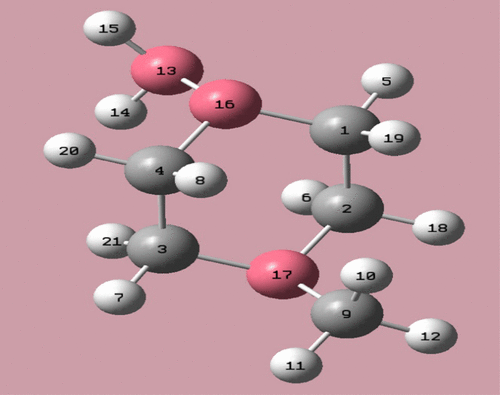当前位置:
X-MOL 学术
›
J. Chem. Eng. Data
›
论文详情
Our official English website, www.x-mol.net, welcomes your
feedback! (Note: you will need to create a separate account there.)
Dissociation Constant (pKa) and Thermodynamic Properties of 1,4-Bis(3-aminopropyl) Piperazine, 1,3-Bis(aminomethyl) Cyclohexane, Tris(2-aminoethyl) Amine, and 1-Amino-4-methyl Piperazine: Study of the Protonation Mechanism Using the Density Function Theory
Journal of Chemical & Engineering Data ( IF 2.0 ) Pub Date : 2020-04-06 , DOI: 10.1021/acs.jced.9b00702 William Hoang Chi Hieu Nguyen 1 , Amr Henni 1
Journal of Chemical & Engineering Data ( IF 2.0 ) Pub Date : 2020-04-06 , DOI: 10.1021/acs.jced.9b00702 William Hoang Chi Hieu Nguyen 1 , Amr Henni 1
Affiliation

|
This study focuses on determining the dissociation constants as well as other thermodynamic properties for four amines of importance in the area of CO2 capture, namely, 1,4-bis(3-aminopropyl) piperazine, 1,3-bis(aminomethyl)cyclohexane, tris(2-aminoethyl) amine, and 1-amino-4-methylpiperazine. All experiments were done at atmospheric pressure and at seven temperatures in the range of 288.15–323.15 K. The dissociation constants (pKas) were measured using a potentiometric titration. The van’t Hoff equation was used to determine thermodynamic properties such as the enthalpy, entropy, and free energy (ΔH0, ΔS0, and ΔG0) based on the pKa values measured at different temperatures. In addition, Gaussian was used to help explain the influence that the tertiary amine has on the second pKa of 1-amino-4-methylpiperazine. The density functional theory (DFT) was used to optimize the geometries after each protonation step and calculate the bond lengths between the nitrogen to the proton, which can be used as a comparison of the pKa of the amines. pKa values for the four studied amines were also predicted using the Perrin–Dempsey–Serjeant (PDS) model.
中文翻译:

1,4-双(3-氨基丙基)哌嗪,1,3-双(氨基甲基)环己烷,三(2-氨基乙基)胺和1-氨基-4-甲基哌嗪的解离常数(p K a)和热力学性质:使用密度函数理论研究质子化机理
这项研究的重点是确定在CO 2捕集领域重要的四种胺的解离常数以及其他热力学性质,即1,4-双(3-氨基丙基)哌嗪,1,3-双(氨基甲基)环己烷,三(2-氨基乙基)胺和1-氨基-4-甲基哌嗪。所有实验均在大气压力和288.15–323.15 K的七个温度下进行。离解常数(p K a s)使用电位滴定法测量。基于p K,使用van't Hoff方程确定热力学性质,例如焓,熵和自由能(ΔH 0,ΔS 0和ΔG 0)在不同温度下测得的值。另外,使用高斯方法来帮助说明叔胺对1-氨基-4-甲基哌嗪的第二个p K a的影响。密度泛函理论(DFT)用于优化每个质子化步骤后的几何形状,并计算氮与质子之间的键长,可将其用作胺的p K a的比较。还使用Perrin-Dempsey-Serjeant(PDS)模型预测了四种研究的胺的p K a值。
更新日期:2020-04-06
中文翻译:

1,4-双(3-氨基丙基)哌嗪,1,3-双(氨基甲基)环己烷,三(2-氨基乙基)胺和1-氨基-4-甲基哌嗪的解离常数(p K a)和热力学性质:使用密度函数理论研究质子化机理
这项研究的重点是确定在CO 2捕集领域重要的四种胺的解离常数以及其他热力学性质,即1,4-双(3-氨基丙基)哌嗪,1,3-双(氨基甲基)环己烷,三(2-氨基乙基)胺和1-氨基-4-甲基哌嗪。所有实验均在大气压力和288.15–323.15 K的七个温度下进行。离解常数(p K a s)使用电位滴定法测量。基于p K,使用van't Hoff方程确定热力学性质,例如焓,熵和自由能(ΔH 0,ΔS 0和ΔG 0)在不同温度下测得的值。另外,使用高斯方法来帮助说明叔胺对1-氨基-4-甲基哌嗪的第二个p K a的影响。密度泛函理论(DFT)用于优化每个质子化步骤后的几何形状,并计算氮与质子之间的键长,可将其用作胺的p K a的比较。还使用Perrin-Dempsey-Serjeant(PDS)模型预测了四种研究的胺的p K a值。


















































 京公网安备 11010802027423号
京公网安备 11010802027423号